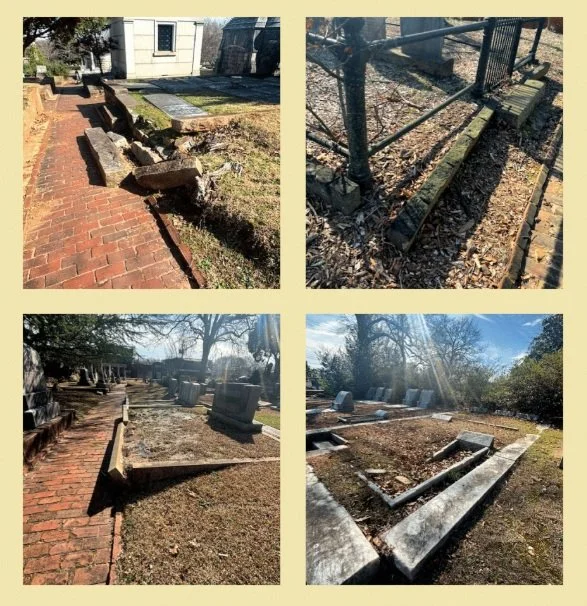Looking Ahead: Restoring Oakland’s Original Six Acres
The first section you walk through after entering through the main gate, Oakland’s Original Six Acres is known by many as the oldest and one of the most beautiful sections of the cemetery. But what you may not have noticed is that after nearly two centuries, many of its paths, monuments, gates, and headstones are in serious need of care.
For that reason, the Original Six Acres is the next focus of Historic Oakland Foundation’s preservation and restoration team. It is a large undertaking: one that will take years to complete and significant funding to support. Keep reading to learn more about this upcoming project and its significance to Oakland.
About the Original Six Acres
The history and stories of this section of the cemetery, founded in 1850, are as diverse and fascinating as the history of Atlanta: Martha Lumpkin Compton, the Governor’s daughter after whom the city was named Marthasville in 1843 before it became Atlanta in 1845; Sarah Todd Ivy, the widow of the City’s first settler Hardy Ivy; Agnes Wooding, the widow of the sites previous owner Alfred W. Wooding; Dr. James Nissen, a travelling physician who was the cemetery’s first interment in 1850; Alfred Austell, the founder of the Atlanta National Bank and railroad tycoon.
And while the section is home to the city’s earliest burials, it is also the place of more recent interments of people who have transformed this city in more recent times, most prominently the city’s first Black mayor Maynard Holbrook Jackson.
It is not only the wealthy and prominent, however, whose souls reside in the gently undulating slopes of the Original Six Acres. Those with names unknown to the history books but still crucial to the history of Oakland and Atlanta take their eternal rest under the cemetery’s oldest tree canopy that gave City Cemetery its name Oakland in the 1870s: Thomas and Joseph Barfield, the sons of Oakland’s Sexton Henry H. Barfield, both of whom worked for a time at the cemetery. To the unknown poor buried in the cemetery’s original pauper burial grounds: the North and South Public Grounds.
The list of notable names and families buried in the Original Six Acres is long and rich: a true reflection of the city’s history.
Preservation & Restoration: Why it matters
The first two acres this section was restored fifteen years ago as the Foundation worked to restore and improve the area immediately inside the cemetery’s main, western gate (and the intersection of MLK and Oakland Ave). However, the remaining four acres of the Original Six Acres have barely been cared for in the last 175 years.
The Original Six Acres houses irreplaceable pieces of funerary architecture that are the most critically in danger from the ravages of time and nature, including the cemetery’s earliest grave markers and oldest brick walkways and some of the most prominent mausolea and statues. Additionally, the cemetery’s oldest trees that line the paths and roadways desperately need specialized care to ensure their health and longevity.
As the Foundation’s Preservation team restores and preserves the hardscape, our talented team of horticulturalists will install beautiful gardens drawing on the inspiration of the nineteenth century tradition rural garden cemetery movement. Filling these acres with hundreds of individually designed gardens not only beautifies the area for visitors and families alike, but provides enormous environmental benefits, including new habitats for birds and bugs, that leads to a healthier environment for all.
In addition to being the cemetery’s oldest and most endangered hardscape and landscape, the Original Six Acres are the cemetery’s most visible, as this section is a front door for visitors entering from either the main, western gate or the pedestrian gate on Memorial Drive across from Six Feet Under. As more and more people move back into the City, Downtown goes through a revival led by the Stitch and Centennial Yards projects and the forthcoming arrival of hundreds of thousands of visitors during the 2026 FIFA World Cup, and the new Visitor Center draws new visitors and eyes on Oakland, the time is now to make major physical and aesthetic improvements to Oakland’s “front door” and deliver a dramatic first impression that cements Oakland’s historic and cultural importance in the minds of all who visit.
Looking Ahead
Historic Oakland Foundation restored the East Hill during the Living History capital campaign at an average rate of two acres of restoration per year. With full funding, the hardscape and landscape of these four acres will take two years, from kick-off in 2026 to completion in 2027. Projects will also serve as educational and skill-building opportunities for Preservation Interns and Oakland’s Youth Landscape and Hardscape Team who will work under the guidance of Oakland’s preservation specialists.
Follow along on Instagram for real-time updates as projects are completed.
How can I contribute?
Oakland’s restoration projects are possible thanks to generous contributions from donors. By supporting restoration at Oakland, you help preserve Atlanta’s history and honor every life, known and unknown, within our grounds. Your support is incredibly meaningful to not only the descendants and loved ones of those buried at Oakland, but also to the wider Atlanta community, to whom Oakland serves as a public greenspace, outdoor museum, and living archive of the city’s rich history. To support the Original Six Acres restoration project, donate here.



